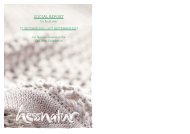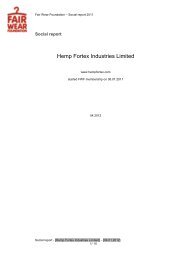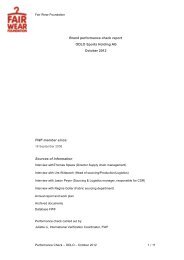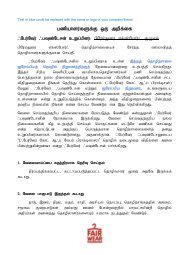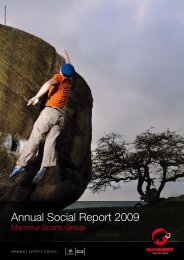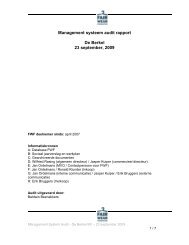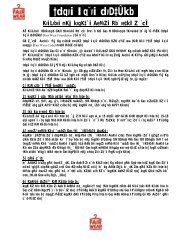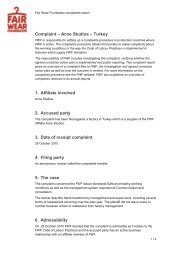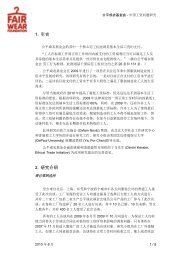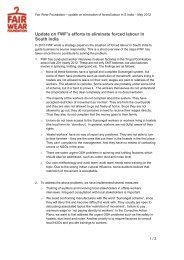Background Study Tirupur - Fair Wear Foundation
Background Study Tirupur - Fair Wear Foundation
Background Study Tirupur - Fair Wear Foundation
Create successful ePaper yourself
Turn your PDF publications into a flip-book with our unique Google optimized e-Paper software.
units of for example 5 members. These contribute significantly to the export of<br />
garments.<br />
Main issues are dust, fire safety, hot pipes and fumes (ironing), electrical appliances<br />
and wires, eye protection (buttoning), and jobs that require people to stand<br />
all day. Other issues are may be air ventilation, sufficient space for each workers, potable<br />
drinking water, sufficient toilets, emergency exits, medical expenses in case of accident, first<br />
aid box and health check up. Medical doctors are present in some factories.<br />
According to the workers, during peak production season, there exists a total congestion<br />
when many workers used to work at that particular point of time.<br />
Very few companies provide crèches in <strong>Tirupur</strong>. Most children are in villages far away. There<br />
is a social system that the family takes care for the children. But if crèches are made available<br />
workers will start to use it!<br />
Accidents registers have to be maintained but always show nil entries. Companies are afraid<br />
to run into problems with the factory inspector. Some auditors ask management to maintain<br />
an informal register to at least see what is happening or what prevention measures should be<br />
taken.<br />
Interview with Peace Trust (Mr. Paul Baskar): ‘About half of the workforce in garment units is<br />
migrant workers. These workers stay or are housed in unhygienic conditions and cramped<br />
accommodation. This should change. TEA could build common houses, bachelor quarters,<br />
quarters for women workers. Even NGOs could do this. Migrant workers is an important aspect<br />
of labour conditions that should be looked into in the Audit.<br />
Proper lighting and ventilation in the workplace is important. Canteen or if not a canteen, at<br />
least a spacious room where workers can take food away from the cluttered up or dusty<br />
workplace is necessary. Protective gears like earplugs and gloves are important. Posture<br />
problems lead to back ache and pain in the joints. Chairs with hard seats need to be replaced<br />
by wire mesh seats as otherwise health problems like piles (hemorrhoids) result.<br />
Steps to clear dust and fine particles of cotton, thread or foam to prevent workers being afflicted<br />
by asthma and other respiratory ailments. Most of all, information boards on health,<br />
occupational hazards should be kept at appropriate places in the work area and the rest<br />
rooms. These information boards should also promote awareness about HIV. This is especially<br />
important because of the large proportion of migrant labour in the garment sector workforce,<br />
and migrant labour is a vulnerable group in this regard. ‘<br />
Dormitories may not be company owned but shared by a number of companies..<br />
4.8. Legally Binding Employment Relationship<br />
4.8.1. Laws and Regulations<br />
The Contract labour (regulation and Abolition) Act, 1970<br />
• The contractor must pay wages to the workers every month on a fixed date. When a contractor<br />
terminates the employment of any worker, his/her wages must be paid before the<br />
expiry of the second working day from the day on which his employment is terminated.<br />
• Wages must be paid to the workers on working days at the work site on a fixed time. If<br />
the work is completed before the expiry of the wage period, final payment shall be made<br />
within 48 hours of the last working day.<br />
• Wages must be given directly to the worker or to a person authorized by him.<br />
• No deduction in the wages of a worker is permissible except that which is specified by the<br />
order of the government.<br />
41



